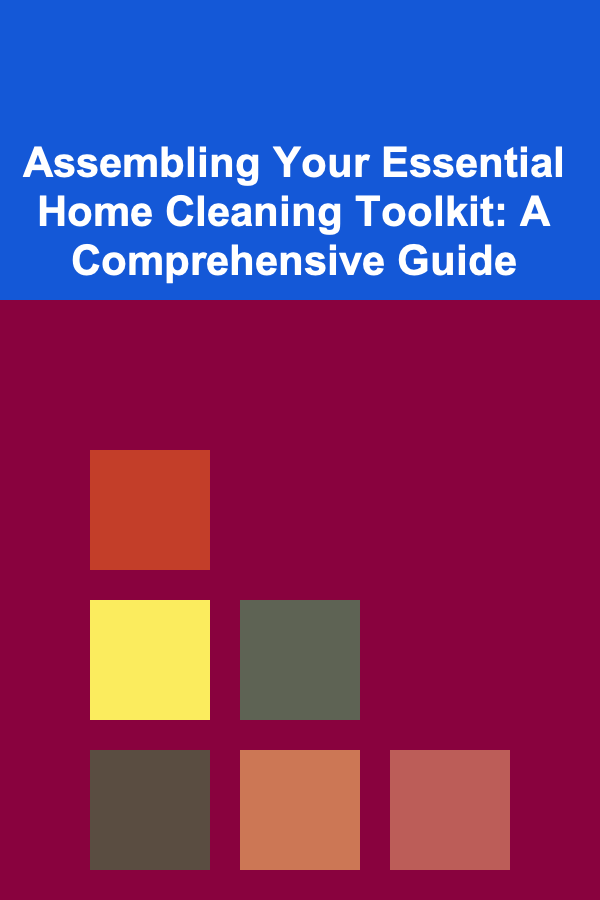
Assembling Your Essential Home Cleaning Toolkit: A Comprehensive Guide
ebook include PDF & Audio bundle (Micro Guide)
$12.99$9.99
Limited Time Offer! Order within the next:

Maintaining a clean and organized home is crucial for both physical and mental well-being. A well-equipped cleaning toolkit makes the task significantly easier and more efficient, transforming it from a daunting chore into a manageable routine. This guide provides a comprehensive overview of the essential tools and supplies you need to create an effective home cleaning toolkit, covering everything from basic essentials to specialized items for specific cleaning needs. We'll also discuss proper storage, maintenance, and safety considerations to ensure your toolkit is always ready to tackle any mess.
I. The Foundation: Essential Cleaning Tools
These are the absolute must-haves -- the workhorses of your cleaning arsenal. Without these, even the most effective cleaning solutions will struggle to make a significant impact.
A. Microfiber Cloths: The Versatile Cleaning Champions
Microfiber cloths have revolutionized cleaning due to their exceptional absorbency and ability to trap dust, dirt, and grime. Unlike traditional cotton cloths, microfiber cloths are made of tightly woven synthetic fibers that are split to create microscopic hooks, effectively grabbing and holding onto particles. They are also lint-free, streak-free, and reusable, making them an environmentally friendly and cost-effective choice.
- Why Microfiber? Superior absorbency, traps dust and dirt effectively, lint-free, streak-free, reusable and washable.
- Recommended Usage: Dusting, wiping surfaces, cleaning mirrors and windows, polishing furniture, general cleaning.
- Number Needed: Aim for at least a dozen. Color-code them (e.g., blue for bathrooms, green for kitchen) to prevent cross-contamination.
- Care: Wash regularly in warm water with mild detergent. Avoid fabric softeners, as they can reduce the effectiveness of the microfiber. Tumble dry on low heat or air dry.
B. All-Purpose Cleaner: The Go-To Solution for Most Surfaces
An all-purpose cleaner is a versatile cleaning solution designed to tackle a wide range of messes on various surfaces. Look for a pH-balanced formula that is safe for use on countertops, floors, appliances, and other common household surfaces. Consider both liquid and spray options for different cleaning tasks. Many commercially available all-purpose cleaners are effective, but you can also create a DIY version using simple ingredients like vinegar and water.
- Commercial vs. DIY: Both options are viable. Commercial cleaners offer convenience, while DIY cleaners are often more eco-friendly and cost-effective.
- DIY Recipe (Vinegar-Based): Mix equal parts white vinegar and water in a spray bottle. Add a few drops of essential oil (e.g., lemon, lavender) for fragrance.
- Surfaces to Use On: Countertops, floors, appliances (exterior), sinks, showers (with caution). Always test on an inconspicuous area first.
- Surfaces to Avoid: Natural stone (marble, granite), unsealed wood, electronics.
C. Scrub Brush: For Stubborn Dirt and Grime
A good scrub brush is essential for tackling stubborn dirt, grime, and stains on hard surfaces. Choose a brush with durable bristles that can withstand heavy use. Consider having different types of scrub brushes for specific tasks, such as a grout brush for cleaning tile grout and a larger brush for scrubbing floors.
- Bristle Types: Nylon bristles are suitable for most cleaning tasks. Stiffer bristles are better for tough stains and grout.
- Handles: Choose a brush with a comfortable handle that provides a good grip.
- Specialized Brushes: Grout brushes, toilet bowl brushes, dish brushes.
- Cleaning and Maintenance: Rinse thoroughly after each use and allow to air dry. Replace when bristles become worn or damaged.
D. Mop and Bucket: For Clean and Sanitary Floors
A mop and bucket are essential for cleaning floors, removing dirt, dust, and spills. There are various types of mops available, each with its own advantages and disadvantages. Consider the type of flooring you have when choosing a mop. Microfiber mops are generally a good choice for most types of floors, as they are absorbent and effective at removing dirt.
- Types of Mops: String mops, sponge mops, flat mops (microfiber), steam mops.
- Bucket Considerations: Choose a bucket with a wringer to effectively squeeze out excess water from the mop.
- Suitable for: Hardwood, tile, laminate, vinyl flooring. Check manufacturer's recommendations for specific flooring types.
- Cleaning and Maintenance: Rinse the mop head thoroughly after each use. Replace mop heads regularly. Clean the bucket with soap and water.
E. Vacuum Cleaner: The Dust and Debris Eliminator
A vacuum cleaner is an indispensable tool for removing dust, dirt, and debris from carpets, rugs, and hard floors. Choose a vacuum cleaner that is appropriate for the size and type of flooring in your home. Consider factors such as suction power, filtration, and maneuverability. Upright vacuums are generally more powerful and suitable for larger areas, while canister vacuums are more versatile and easier to maneuver around furniture.
- Types of Vacuum Cleaners: Upright vacuums, canister vacuums, stick vacuums, robotic vacuums, handheld vacuums.
- Features to Consider: Suction power, filtration (HEPA filter for allergy sufferers), attachments (crevice tool, dusting brush), maneuverability, weight.
- Maintenance: Empty the dustbin or bag regularly. Clean or replace filters as recommended by the manufacturer. Check for and remove any clogs.
- Choosing the Right One: Consider the type of flooring in your home (carpet, hardwood, tile), the size of your home, and your budget.
II. Specialized Cleaning Supplies for Targeted Needs
While an all-purpose cleaner covers many bases, certain areas and messes require specialized solutions. These supplies address those specific needs, ensuring a thorough and effective clean.
A. Glass Cleaner: For Sparkling Windows and Mirrors
Glass cleaner is specifically formulated to remove streaks, smudges, and dirt from glass surfaces, leaving them sparkling clean. Look for a glass cleaner that is ammonia-free, as ammonia can damage some glass and mirror surfaces. You can also create a DIY glass cleaner using vinegar and water.
- Commercial vs. DIY: Commercial cleaners often contain detergents for enhanced cleaning power. DIY cleaners are a more eco-friendly option.
- DIY Recipe (Vinegar-Based): Mix equal parts white vinegar and water in a spray bottle.
- Application Tips: Spray glass cleaner onto a microfiber cloth and wipe the surface. Use a clean, dry microfiber cloth to buff the surface to a streak-free shine.
- Surfaces: Windows, mirrors, glass shower doors, car windows.
B. Bathroom Cleaner: For Soap Scum and Grime
Bathroom cleaner is designed to remove soap scum, hard water stains, mildew, and other common bathroom messes. Look for a bathroom cleaner that contains disinfecting agents to kill bacteria and germs. Consider using a cleaner specifically designed for tubs and showers, as these areas tend to accumulate more soap scum and grime.
- Key Ingredients: Disinfectants (e.g., bleach, hydrogen peroxide), surfactants (to remove soap scum), chelating agents (to remove hard water stains).
- Application Tips: Spray bathroom cleaner onto the surface and let it sit for a few minutes before scrubbing. Rinse thoroughly with water.
- Surfaces: Tubs, showers, sinks, toilets, tile, grout.
- Safety Precautions: Wear gloves and eye protection when using bathroom cleaner. Ensure adequate ventilation. Do not mix bleach with other cleaning products.
C. Disinfectant Wipes: For Quick and Easy Sanitizing
Disinfectant wipes are a convenient way to quickly sanitize surfaces, killing bacteria and germs. They are ideal for cleaning countertops, doorknobs, light switches, and other frequently touched surfaces. Choose disinfectant wipes that are EPA-registered and effective against a broad range of bacteria and viruses.
- EPA Registration: Ensure the wipes are EPA-registered and listed to kill specific pathogens.
- Proper Usage: Wipe the surface and allow it to remain wet for the recommended contact time (usually several minutes) before wiping dry.
- Surfaces: Countertops, doorknobs, light switches, toilet seats, keyboards, cell phones.
- Environmental Considerations: Choose biodegradable or compostable wipes when possible.
D. Toilet Bowl Cleaner: For a Sparkling and Sanitary Toilet
Toilet bowl cleaner is specifically formulated to remove stains, mineral deposits, and bacteria from the toilet bowl. Choose a toilet bowl cleaner that contains disinfecting agents and a strong cleaning formula. Consider using a cleaner with a nozzle that can reach under the rim of the toilet bowl.
- Types of Toilet Bowl Cleaners: Liquid cleaners, gel cleaners, tablets.
- Application Tips: Apply toilet bowl cleaner under the rim of the toilet bowl and let it sit for a few minutes before scrubbing with a toilet brush. Flush the toilet to rinse.
- Ingredients to Look For: Hydrochloric acid, sodium hypochlorite (bleach), surfactants.
- Safety Precautions: Wear gloves and eye protection when using toilet bowl cleaner. Ensure adequate ventilation. Do not mix bleach with other cleaning products.
E. Oven Cleaner: For Removing Baked-On Grease and Food
Oven cleaner is a powerful cleaning solution designed to remove baked-on grease, food, and grime from ovens. Choose an oven cleaner that is specifically formulated for self-cleaning ovens, if applicable. Follow the manufacturer's instructions carefully when using oven cleaner, as it can be corrosive and harmful.
- Types of Oven Cleaners: Aerosol sprays, gels, fume-free options.
- Application Tips: Remove oven racks and clean them separately. Apply oven cleaner to the interior of the oven, avoiding heating elements. Let it sit for the recommended time, then wipe clean with a damp cloth.
- Safety Precautions: Wear gloves and eye protection when using oven cleaner. Ensure adequate ventilation. Do not use oven cleaner on self-cleaning ovens unless specifically instructed by the manufacturer.
- Alternative Options: Consider using a baking soda and vinegar paste as a natural alternative to oven cleaner.
III. Tools for Dusting and Polishing
Removing dust and polishing surfaces are essential for maintaining a clean and attractive home. These tools will help you keep your furniture, floors, and other surfaces looking their best.
A. Duster: For Removing Dust from Surfaces
A duster is a tool used to remove dust from surfaces. There are various types of dusters available, including microfiber dusters, feather dusters, and electrostatic dusters. Microfiber dusters are generally the most effective, as they trap dust and dirt rather than simply scattering it.
- Types of Dusters: Microfiber dusters, feather dusters, electrostatic dusters.
- Extendable Dusters: Useful for reaching high ceilings, fans, and other hard-to-reach areas.
- Cleaning and Maintenance: Wash microfiber duster heads regularly. Shake out feather dusters to remove dust.
- Suitable for: Furniture, shelves, blinds, ceiling fans, light fixtures.
B. Furniture Polish: For Protecting and Enhancing Wood Surfaces
Furniture polish is used to protect and enhance the appearance of wood surfaces. Choose a furniture polish that is appropriate for the type of wood you have. Some furniture polishes also contain cleaning agents to remove dust and grime.
- Types of Furniture Polish: Aerosol sprays, liquids, creams.
- Ingredients to Look For: Beeswax, carnauba wax, oils.
- Application Tips: Apply furniture polish to a clean, dry cloth and wipe the surface in the direction of the wood grain. Buff with a clean, dry cloth to a shine.
- Safety Precautions: Use furniture polish in a well-ventilated area. Avoid using furniture polish on surfaces that come into contact with food.
C. Floor Polish: For Maintaining the Shine of Hard Floors
Floor polish is used to maintain the shine and protect hard floors, such as hardwood, tile, and laminate. Choose a floor polish that is specifically designed for the type of flooring you have. Some floor polishes also contain cleaning agents to remove dirt and grime.
- Types of Floor Polish: Acrylic polishes, wax polishes, polyurethane polishes.
- Application Tips: Apply floor polish to a clean, dry floor using a mop or applicator. Follow the manufacturer's instructions carefully.
- Safety Precautions: Use floor polish in a well-ventilated area. Avoid walking on the floor until the polish is completely dry.
- Choosing the Right One: Consider the type of flooring you have and the desired level of shine.
IV. Safety Gear and Accessories
Cleaning can involve exposure to harsh chemicals and potential hazards. Safety gear is crucial for protecting yourself and ensuring a safe cleaning experience.
A. Gloves: Protecting Your Hands from Chemicals and Irritants
Gloves are essential for protecting your hands from harsh chemicals, irritants, and bacteria. Choose gloves that are durable, waterproof, and comfortable to wear. Latex gloves are a common choice, but if you have a latex allergy, opt for nitrile or vinyl gloves.
- Types of Gloves: Latex gloves, nitrile gloves, vinyl gloves.
- Durability: Choose gloves that are thick and durable enough to withstand repeated use.
- Fit: Select gloves that fit snugly but comfortably.
- Cleaning and Maintenance: Rinse gloves after each use and allow to air dry. Replace gloves when they become torn or damaged.
B. Eye Protection: Shielding Your Eyes from Splashes and Sprays
Eye protection is important for shielding your eyes from splashes and sprays of cleaning solutions. Choose safety glasses or goggles that provide a comfortable and secure fit.
- Types of Eye Protection: Safety glasses, goggles, face shields.
- Features to Look For: Impact resistance, chemical resistance, anti-fog coating.
- Fit: Choose eye protection that fits snugly and provides adequate coverage.
- Cleaning and Maintenance: Clean eye protection with soap and water after each use.
C. Masks: Protecting Your Lungs from Dust and Fumes
Masks can help protect your lungs from dust, fumes, and other airborne particles. Choose a mask that is appropriate for the type of cleaning you are doing. For general cleaning, a disposable dust mask may be sufficient. For more intensive cleaning tasks, such as using harsh chemicals, consider using a respirator.
- Types of Masks: Dust masks, respirators (N95, P100).
- Fit: Choose a mask that fits snugly and provides a good seal around your nose and mouth.
- Usage: Replace disposable masks after each use. Clean and maintain respirators according to the manufacturer's instructions.
- When to Use: When working with harsh chemicals, when cleaning dusty areas, when dealing with mold or mildew.
D. Sponges: Versatile Cleaning Tools for Various Tasks
Sponges are useful for a variety of cleaning tasks, from wiping surfaces to scrubbing dishes. Choose sponges that are absorbent and durable. Consider having different types of sponges for different tasks, such as a non-scratch sponge for delicate surfaces and a scouring sponge for tough stains.
- Types of Sponges: Cellulose sponges, synthetic sponges, scouring sponges, non-scratch sponges.
- Cleaning and Maintenance: Rinse sponges thoroughly after each use and allow to air dry. Microwave sponges for two minutes to kill bacteria. Replace sponges regularly.
- Tips: Label sponges for specific tasks (e.g., kitchen, bathroom) to prevent cross-contamination.
E. Spray Bottles: For Diluting and Dispensing Cleaning Solutions
Spray bottles are essential for diluting and dispensing cleaning solutions. Choose spray bottles that are durable and leak-proof. Label each spray bottle clearly to identify the contents.
- Material: Choose spray bottles made of durable plastic that can withstand repeated use.
- Nozzle: Select spray bottles with adjustable nozzles that can produce a fine mist or a strong stream.
- Labeling: Label each spray bottle clearly with the name of the cleaning solution and any safety precautions.
- Safety: Store spray bottles out of reach of children and pets.
V. Storage, Maintenance, and Organization
A well-organized and maintained cleaning toolkit is just as important as having the right tools. Proper storage ensures your supplies are readily accessible and protected from damage, while regular maintenance extends their lifespan.
A. Choosing the Right Storage Container: Caddies, Baskets, and Cabinets
Select a storage container that is appropriate for the size and type of your cleaning toolkit. Options include cleaning caddies, baskets, and cabinets. Cleaning caddies are portable and convenient for carrying supplies from room to room. Baskets are a good option for storing cleaning cloths and sponges. Cabinets provide a more organized and secure storage solution.
- Cleaning Caddies: Portable and convenient for carrying supplies.
- Baskets: Ideal for storing cleaning cloths and sponges.
- Cabinets: Provide a more organized and secure storage solution.
- Location: Store your cleaning toolkit in a central location that is easily accessible.
B. Organizing Your Supplies: Categorizing and Labeling
Organize your cleaning supplies by category, such as cleaning solutions, tools, and safety gear. Label each item clearly to identify its contents and purpose. This will make it easier to find what you need when you need it.
- Categorization: Group similar items together.
- Labeling: Use clear and concise labels.
- Prioritization: Keep frequently used items within easy reach.
- Inventory: Regularly check your supplies and restock as needed.
C. Proper Maintenance: Cleaning and Replacing Tools
Regularly clean and maintain your cleaning tools to extend their lifespan and ensure they are effective. Rinse sponges and cloths after each use. Wash mop heads and duster heads regularly. Replace worn or damaged tools as needed.
- Cleaning Cloths and Sponges: Rinse thoroughly after each use and allow to air dry. Microwave sponges to kill bacteria.
- Mop Heads and Duster Heads: Wash regularly according to the manufacturer's instructions.
- Vacuum Cleaner: Empty the dustbin or bag regularly. Clean or replace filters as recommended by the manufacturer.
- Replacement Schedule: Replace worn or damaged tools as needed.
D. Safety First: Storing Chemicals Securely and Keeping Out of Reach of Children and Pets
Store cleaning chemicals securely and out of reach of children and pets. Keep chemicals in their original containers and label them clearly. Never mix different cleaning chemicals, as this can create hazardous fumes. Ensure adequate ventilation when using cleaning chemicals.
- Secure Storage: Store chemicals in a locked cabinet or on a high shelf.
- Original Containers: Keep chemicals in their original containers with clear labels.
- Ventilation: Ensure adequate ventilation when using cleaning chemicals.
- Emergency Information: Keep emergency contact information readily available.
VI. Building a Budget-Friendly Toolkit
A comprehensive cleaning toolkit doesn't have to break the bank. By prioritizing essentials, opting for DIY solutions, and taking advantage of sales and discounts, you can assemble a highly effective toolkit without overspending.
A. Prioritizing Essential Items: Focus on Versatility and Effectiveness
Start by focusing on the essential items that will provide the most versatility and effectiveness. This includes microfiber cloths, an all-purpose cleaner, a scrub brush, a mop and bucket, and a vacuum cleaner. These items can be used for a wide range of cleaning tasks.
- Start with the Basics: Microfiber cloths, all-purpose cleaner, scrub brush, mop and bucket, vacuum cleaner.
- Prioritize Versatility: Choose items that can be used for multiple cleaning tasks.
- Quality over Quantity: Invest in durable and effective tools.
B. DIY Cleaning Solutions: Eco-Friendly and Cost-Effective Alternatives
Consider using DIY cleaning solutions made from simple ingredients like vinegar, baking soda, and lemon juice. These solutions are eco-friendly, cost-effective, and often just as effective as commercial cleaners.
- Vinegar-Based Cleaners: Excellent for cleaning glass, countertops, and floors.
- Baking Soda Paste: Effective for removing stains and scrubbing surfaces.
- Lemon Juice: Can be used as a disinfectant and deodorizer.
- Resources: Search online for DIY cleaning solution recipes.
C. Shopping Smart: Sales, Discounts, and Generic Brands
Take advantage of sales, discounts, and coupons when purchasing cleaning supplies. Consider buying generic brands, which are often just as effective as name-brand products but cost less.
- Sales and Discounts: Watch for sales and discounts at local stores.
- Coupons: Use coupons to save money on cleaning supplies.
- Generic Brands: Consider buying generic brands to save money.
- Bulk Purchases: Buy in bulk when possible to save money on frequently used items.
VII. Advanced Cleaning: Tools for Specialized Tasks
Once you have your essential toolkit assembled, you might consider adding some specialized tools for tackling more advanced cleaning tasks. These tools can help you achieve a deeper, more thorough clean.
A. Steam Cleaner: For Sanitizing and Deep Cleaning
A steam cleaner uses hot steam to sanitize and deep clean surfaces without the use of chemicals. It's effective for cleaning floors, carpets, upholstery, and other surfaces.
- Benefits: Chemical-free cleaning, sanitizes surfaces, deep cleans carpets and upholstery.
- Types: Handheld steam cleaners, steam mops, upright steam cleaners.
- Suitable for: Floors, carpets, upholstery, bathrooms, kitchens.
- Safety Precautions: Use caution when working with hot steam.
B. Pressure Washer: For Outdoor Cleaning
A pressure washer uses high-pressure water to clean outdoor surfaces, such as patios, decks, siding, and driveways. It's effective for removing dirt, grime, mildew, and algae.
- Benefits: Removes dirt, grime, mildew, and algae from outdoor surfaces.
- Safety Precautions: Use caution when operating a pressure washer. Wear eye protection and avoid spraying people or animals.
- Suitable for: Patios, decks, siding, driveways, fences.
- Nozzle Selection: Use the appropriate nozzle for the surface you are cleaning.
C. Upholstery Cleaner: For Refreshing Furniture
Upholstery cleaner is specifically designed to remove stains and dirt from upholstered furniture. It can help refresh and revitalize your furniture, making it look and smell like new.
- Types: Sprays, foams, liquids.
- Testing: Always test upholstery cleaner on an inconspicuous area first.
- Application: Follow the manufacturer's instructions carefully.
- Suitable for: Sofas, chairs, mattresses, car interiors.
D. Grout Cleaner: For Removing Stains and Grime from Grout
Grout cleaner is specifically formulated to remove stains and grime from grout lines. It can help restore the appearance of tile floors and walls.
- Types: Sprays, liquids, powders.
- Application: Apply grout cleaner to the grout lines and let it sit for a few minutes before scrubbing with a grout brush.
- Safety Precautions: Wear gloves and eye protection when using grout cleaner.
- Suitable for: Tile floors, tile walls, showers, backsplashes.
E. Leather Cleaner and Conditioner: For Maintaining Leather Furniture
Leather cleaner and conditioner are essential for maintaining leather furniture. Leather cleaner removes dirt and grime, while leather conditioner helps to moisturize and protect the leather.
- Types: Sprays, creams, liquids.
- Testing: Always test leather cleaner and conditioner on an inconspicuous area first.
- Application: Follow the manufacturer's instructions carefully.
- Frequency: Clean and condition leather furniture every few months.
VIII. Conclusion: A Clean Home, A Clear Mind
Assembling your essential home cleaning toolkit is a worthwhile investment in your home and your well-being. By choosing the right tools and supplies, organizing your toolkit effectively, and following safe cleaning practices, you can make cleaning a more efficient and enjoyable task. A clean and organized home contributes to a more relaxed and productive life. Remember to adapt your toolkit to your specific needs and preferences, and enjoy the benefits of a sparkling clean living space.

How to Master Servant Leadership
Read More
How To Lead Through Change and Uncertainty
Read More
How to Grasp the Concepts of Transcription and Translation
Read More
Mastering Pan-Seared Scallops: A Comprehensive Guide
Read More
Implementing AI in Cybersecurity: A Deep Dive
Read More
How to Make Gel Candles with Embedded Botanicals
Read MoreOther Products

How to Master Servant Leadership
Read More
How To Lead Through Change and Uncertainty
Read More
How to Grasp the Concepts of Transcription and Translation
Read More
Mastering Pan-Seared Scallops: A Comprehensive Guide
Read More
Implementing AI in Cybersecurity: A Deep Dive
Read More